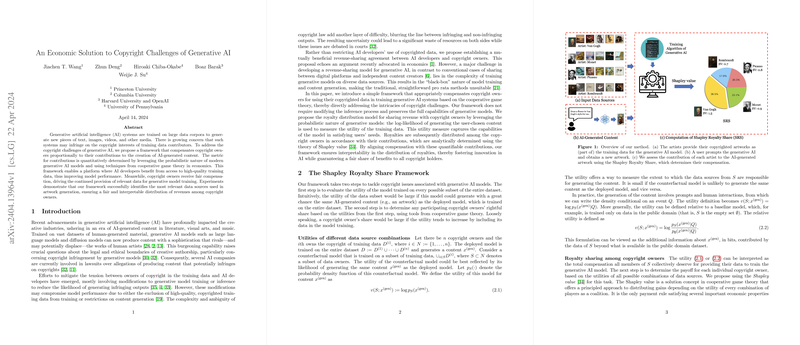Tackling Copyright Challenges in Generative AI through Economic Models
Introduction
Generative AI has transformed the creative industries by producing high-level content from vast data pools of existing human-created material. However, this capability comes with significant legal and ethical concerns, notably copyright infringement. Existing solutions often involve limiting data usage or modifying generative processes, which can degrade model performance. This paper proposes a novel economic framework that establishes a revenue-sharing system between AI developers and copyright owners without compromising the generative capabilities of AI models.
Economic Model Proposal
The core of the proposed solution involves a framework that utilizes cooperative game theory to equitably distribute revenue among copyright stakeholders. This system operates by quantitatively assessing each data source's contribution to the generated content using a metric derived from the probabilistic outputs of generative models. Specifically, contributions are calculated using the Shapley value—a concept from game theory which ensures a fair distribution of payoffs based on individual contributions to the collective output.
Framework Application
- Utility Calculation: The utility of data subsets is measured by their likelihood to produce the desired output compared to a model trained on the entire dataset.
- Shapley Value Calculation: Each copyright owner's share is quantitatively determined based on the incremental utility their data brings when combined with various subsets of other data.
Experimental Results
The implementation of the framework was tested on two datasets — WikiArt and FlickrLogo-27 — focusing on the generation of artistic images and logos. These experiments demonstrated the framework's capability to:
- Attribute revenue shares commensurate with the data's relevance to the generated content.
- Recognize and reward the contributions of diverse data sources in mixed-style content generation.
- Distribute revenue fairly among stakeholders when generating content unrelated to specific copyrighted sources.
Highlights from Tests
- Style-Specific Generation: For AI-generated artworks inspired by specific artists, the framework successfully aligns higher Shapley values with artists whose styles were emulated.
- Mixed-Style Generation: When tasked to blend styles from multiple artists, the framework accurately measured and compensated based on each style's influence on the final artwork.
- Generalization Capability: The framework proved robust across various scenarios, including generating content without direct data antecedents.
Theoretical Implications and Future Directions
This paper not only contributes a practical solution to copyright disputes in the field of AI but also opens up new avenues for applying cooperative game theory in complex AI challenges. The adoption of the Shapley value provides a robust basis for equitable economic transactions in AI-related activities and could influence broader applications in other sectors where data sharing is crucial.
Looking forward, expanding this framework could involve:
- Scalability Improvements: Enhancing computational methods for Shapley value calculation to handle larger data sets and more complex model architectures more efficiently.
- Applicability Extension: Beyond copyright issues, this model could be adapted for revenue sharing among data collaborators in various AI-driven consortia or joint ventures.
Concluding Remarks
The proposed economic framework offers a promising solution to the contentious issue of copyright in generative AI, equipping stakeholders with a tool that respects legal boundaries while fostering technological advancement. With further refinement and adaptation, such approaches have the potential to mitigate significant barriers to innovation in AI and other data-driven domains.
